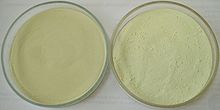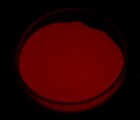Luminous pigment
Luminescent pigments referred to a group of pigments , the more light in the visible region remit , as is irradiated. This effect is also known as luminescence . This distinguishes luminescent pigments from all other types of pigment (white pigments, black pigments, colored pigments and effect pigments). Luminous pigments differ from luminous dyes in that they are insoluble in the application medium.
We distinguish between fluorescent pigments, and daylight fluorescent pigments called, and phosphorescent, even afterglow (as a trade name also Glow Paint called). In general, one speaks of fluorescence when the afterglow lasts less than a thousandth of a second, when the afterglow period is longer, one speaks of phosphorescence .
Special luminous pigments are available under the names Luminova and Lumilux .
history
Minerals glowing in the dark have been reported from ancient times; the Bolognese alchemist Casciarola succeeded in making the first representation of an afterglowing substance while trying to make gold from barium sulfate . The "Bolognese light stone" obtained in this way is likely to have been a doped barium sulfide. Phosphorescence was only examined in more detail at the end of the 19th century, including by Becquerel .
composition
Inorganic afterglow pigments consist of an inorganic basic structure and doping with an activator, as well as mostly co-activators. Basically two types are used: the somewhat older pigments based on sulfides , mostly zinc sulfide or calcium sulfide , and the more modern luminescent pigments based on alkaline earth aluminates, e.g. B. strontium aluminate . The doping is often done with europium . ZnS pigments that glow green are usually doped with copper.
mechanism
Both pigment types initially absorb energy through irradiation ( optical brightener ). In the case of daytime luminescent pigments, UV light is absorbed and immediately emitted in the visible range, while in the case of afterglow pigments, visible light is absorbed and released with a time delay.
The irradiation raises electrons in the excitation centers, where the activators (e.g. foreign atoms) are located, to a higher energy level (“charging”). With longer exposure a state of saturation is reached after which no more energy can be absorbed. When returning to the basic state, the energy is released again in the form of visible light.
properties
Afterglow pigments or phosphorescent pigments afterglow after exposure to visible light. This property is used to produce luminescent paints and varnishes in the dark , which have to be charged beforehand by exposure to light. These coating materials are known as afterglow colors . Phosphorescent pigments based on alkaline earth aluminates are much more luminous than zinc sulfide pigments and glow considerably longer; they also have the advantage that they do not turn gray when exposed to UV light . For this they need a longer time to saturate.
- Afterglow pigments green
- Afterglow pigments red and blue
As with colored pigments, colors can also be mixed from luminescent pigments . When assessing the color , however, it must be noted that afterglow pigments have two color loci , which are usually not identical. One color point is visible under normal lighting, while the other is visible in the dark.
Applications
Fluorescent pigments are rarely used because fluorescent dyes are preferably used for applications in neon colors , since no higher level of fastness is required.
The most important applications for phosphorescent pigments are clocks with dials that can be seen in the dark and guide markings for emergency exits.
The fluorescent inks also include some optical brighteners in detergents (which in white goods means that they begin to glow intensely when exposed to UV light, even through the outer clothing), colourants with this property are marketed as black light fluorescent paint or UV fluorescent paint .
Individual evidence
- ↑ DIN 55943: 2001-10; Colorants: terms.
- ↑ a b c Description of luminescent pigments at Kremer Pigments ( page no longer available , search in web archives ) Info: The link was automatically marked as defective. Please check the link according to the instructions and then remove this notice. .
- ↑ Entry on phosphors. In: Römpp Online . Georg Thieme Verlag, accessed on June 8, 2014.
- ↑ Honeywell Industrial lumilux website. Honeywell , accessed September 10, 2017 .
- ↑ Page no longer available , search in web archives: Lumilux -Pigmente - Honeywell website ( page no longer available , search in web archives ) Info: The link was automatically marked as defective. Please check the link according to the instructions and then remove this notice. (PDF; 92 kB).
- ↑ Description of the afterglow pigment Luminova on the company website of Nemoto ( Memento of the original from December 5, 2008 in the Internet Archive ) Info: The archive link was inserted automatically and has not yet been checked. Please check the original and archive link according to the instructions and then remove this notice.
- ↑ Patent EP0622440 : Phosphorescent phosphor. Published November 2, 1994 , Inventors: Yoshihiko Murayam, Nobuyoshi Takeuchi, Yasumitsu Aoki, Takashi Matsuzawa.
- ↑ Entry on luminescent pigments. In: Römpp Online . Georg Thieme Verlag, accessed on June 8, 2014.
- ↑ RC TRITEC Ltd .: Special Colors ( Memento of the original dated December 31, 2008 in the Internet Archive ) Info: The archive link was inserted automatically and has not yet been checked. Please check the original and archive link according to the instructions and then remove this notice. .







